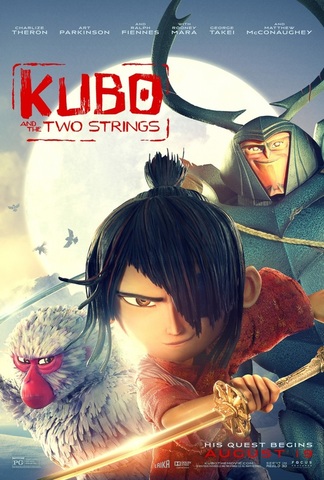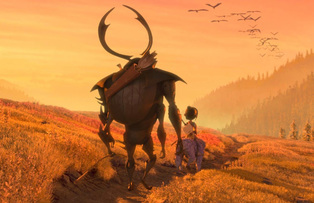Written by Mike Cervantes Laika. It is an animation studio that serves as one of NBC/Universal's best kept secrets. Emerging from the ashes of the dispossessed-of-Will-Vinton studios, and helmed by Henry Selick, the director of A Nightmare Before Christmas, it serves as the last refuge of a quickly dying art form in modern motion pictures, that of the stop-motion animated film. It is an art that goes hand in hand with cinematography itself in practice, from those earliest George Pal Puppetoons, to the body of work of famed special effects artist Ray Harryhausen. This is the fourth film in as eight years to be released by the studio, beginning with its premiere effort, Coraline, to 2014 year’s critically acclaimed but box-office neglected sleeper hit, The Boxtrolls. These four films, along with Selick’s The Corpse Bride, have illustrated the sheer talent, the spectacle of animation, and the depth of storytelling that the studio has been consistently capable of. Sadly, they also have reported some of the lowest box office numbers in the history of summer movie releases for animated films. Kubo and the Two Strings has only been out a week so far, and it has already achieved the title of weakest weekend opening of any of Laika’s films. It’s a shame, really, that this keeps happening to such an amazing studio, one that has at different points had visionaries like Selick and author Neil Gaiman behind it. One that ventures to go beyond even what Disney/Pixar is doing in the animated film format; breathing animated life into its plastic maquettes and giving them more joy and pain in their lives than any CG movie about talking inanimate objects ever could. Kubo is in fact the third of these four films to have a completely original screenplay, and it plays out on the screen in a way that is so intimate and telling of its author’s conviction that…well, it’d give away the movie to analyze just how much. 14 year old Art Parkinson plays Kubo, a small child whose life begins with the legend of how he was spirited away by his mother in order to be protected from a force of mysterious evil helmed by his grandfather (Ralph Feinnes), who gouged out his right eye, and additionally caused the disappearance of his father, the legendary samurai Hanzo. In addition to taking care of his rapidly weakening mother, he follows in the tradition of storytelling with the aid of his three-stringed shamisen, which has the ability to turn paper into living origami animals. One night, Kubo attempts to summon his father among the townspeoples’ festival of the dead, causing him to stay out past nighfall, and summon his aunts, multiple white-masked witches, all voiced by Rooney Mara. Kubo’s mother sacrifices herself one last time to send Kubo far away in search of the three pieces of legendary armor that will defeat the evil of his grandfather for good.  Once Kubo is set on this quest, the most familiar sets and scene-pieces of this film unfold. (Origami pun intended.) Charlize Theron plays Kubo’s monkey guardian, just a wooden charm given to him by his mother, she plays the role of strong protector with the same vive in her voice that she provides to the strong feminist roles she has portrayed in live action. Matthew McConaughey similarly disappears into his role as Beetle, a samurai warrior cursed by Kubo’s family to take the form of a human-sized black beetle. Kubo travels with these two in order to discover everything about his past, to learn his role within destiny, and to redeem the great evil which caused him his tragedy. You’re supposed to look at the movie as a traditional Japanese narrative, even though it isn’t, it is an original screenplay. The only Japanese actor in the entire picture is in fact George Takei, who only has a few lines as one of the many townspeople. However, the trickiness of the overall story is that it isn’t really even about its Japanese aesthetic either. Strip that away and you have the relationship of a small, creative, child and his family, the nuances of which would be too much to tell as, once again, I’d spoil much of the film. The general theme though is of the importance of story in society, how permitting one's self to appreciate mankind’s oldest tradition is the one thing that makes us all human beings. Laika’s usual pedigree is at play here. We see all that the stop motion art form can currently apply, with the minor addition of some CG water and facial expressions that have been rendered with the aid of a 3-D printer. All of these stop motion movies seek to make some sort of achievement, and in the case of this film, it is that they actually animated a six foot tall skeleton torso puppet using a series of cranes, a green screen, and some standard camera work for one of the key action scenes. It is such a feat that they show part of the process during the film’s credits. It is impressive in both the place it stands in the film, and how it was achieved by the animators, who went the extra mile to show the stop motion itself is this film’s finest effect. This review is going to be a bit brief because this is as far as I can go describing the film without giving away what I feel should be best experienced. I would like to add, though, that this is a film that absolutely NEEDS to be experienced, more than any film I’ve reviewed this year. I’m not going to go on a tirade about pulling up the sagging box office numbers. I know Laika will always be employed for its ability to create quality work in one of our oldest filmmaking traditions. Just…whenever you do have the opportunity to see this film, whether it’s on DVD shelves, through digital streaming, or in your grocery store’s Redbox, do NOT hesitate. This movie will make you feel something deeper than the simple enjoyment of cinema. It will make you love everything about art, the people who make it, and the people surrounding the people who make it. Take it from me. Best movie of the summer.
0 Comments
Leave a Reply. |
Archives
March 2025
|
|
© 2012-2025, Nerds That Geek LLC.
All Rights Reserved. |
uWeb Hosting by FatCow


 RSS Feed
RSS Feed